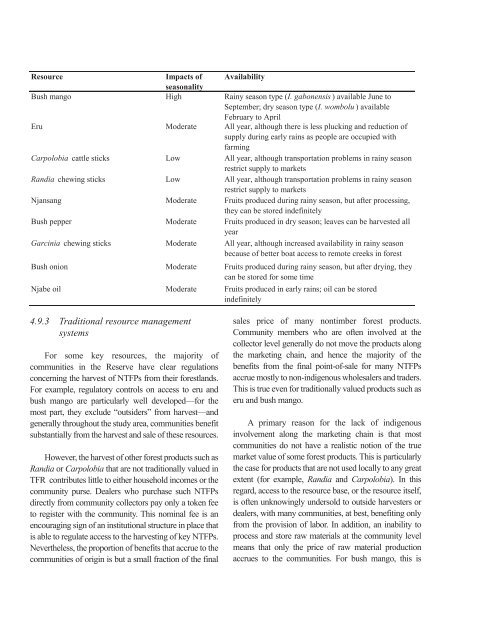Fisheries in the Southern Border Zone of Takamanda - Impact ...
Fisheries in the Southern Border Zone of Takamanda - Impact ...
Fisheries in the Southern Border Zone of Takamanda - Impact ...
Create successful ePaper yourself
Turn your PDF publications into a flip-book with our unique Google optimized e-Paper software.
Resource <strong>Impact</strong>s <strong>of</strong><br />
seasonality<br />
Availability<br />
Bush mango High Ra<strong>in</strong>y season type (I. gabonensis ) available June to<br />
September; dry season type (I. wombolu ) available<br />
February to April<br />
Eru Moderate All year, although <strong>the</strong>re is less pluck<strong>in</strong>g and reduction <strong>of</strong><br />
supply dur<strong>in</strong>g early ra<strong>in</strong>s as people are occupied with<br />
farm<strong>in</strong>g<br />
Carpolobia cattle sticks Low All year, although transportation problems <strong>in</strong> ra<strong>in</strong>y season<br />
restrict supply to markets<br />
Randia chew<strong>in</strong>g sticks Low All year, although transportation problems <strong>in</strong> ra<strong>in</strong>y season<br />
restrict supply to markets<br />
Njansang Moderate Fruits produced dur<strong>in</strong>g ra<strong>in</strong>y season, but after process<strong>in</strong>g,<br />
<strong>the</strong>y can be stored <strong>in</strong>def<strong>in</strong>itely<br />
Bush pepper Moderate Fruits produced <strong>in</strong> dry season; leaves can be harvested all<br />
year<br />
Garc<strong>in</strong>ia chew<strong>in</strong>g sticks Moderate All year, although <strong>in</strong>creased availability <strong>in</strong> ra<strong>in</strong>y season<br />
because <strong>of</strong> better boat access to remote creeks <strong>in</strong> forest<br />
Bush onion Moderate Fruits produced dur<strong>in</strong>g ra<strong>in</strong>y season, but after dry<strong>in</strong>g, <strong>the</strong>y<br />
can be stored for some time<br />
Njabe oil Moderate Fruits produced <strong>in</strong> early ra<strong>in</strong>s; oil can be stored<br />
<strong>in</strong>def<strong>in</strong>itely<br />
4.9.3 Traditional resource management<br />
systems<br />
For some key resources, <strong>the</strong> majority <strong>of</strong><br />
communities <strong>in</strong> <strong>the</strong> Reserve have clear regulations<br />
concern<strong>in</strong>g <strong>the</strong> harvest <strong>of</strong> NTFPs from <strong>the</strong>ir forestlands.<br />
For example, regulatory controls on access to eru and<br />
bush mango are particularly well developed—for <strong>the</strong><br />
most part, <strong>the</strong>y exclude “outsiders” from harvest—and<br />
generally throughout <strong>the</strong> study area, communities benefit<br />
substantially from <strong>the</strong> harvest and sale <strong>of</strong> <strong>the</strong>se resources.<br />
However, <strong>the</strong> harvest <strong>of</strong> o<strong>the</strong>r forest products such as<br />
Randia or Carpolobia that are not traditionally valued <strong>in</strong><br />
TFR contributes little to ei<strong>the</strong>r household <strong>in</strong>comes or <strong>the</strong><br />
community purse. Dealers who purchase such NTFPs<br />
directly from community collectors pay only a token fee<br />
to register with <strong>the</strong> community. This nom<strong>in</strong>al fee is an<br />
encourag<strong>in</strong>g sign <strong>of</strong> an <strong>in</strong>stitutional structure <strong>in</strong> place that<br />
is able to regulate access to <strong>the</strong> harvest<strong>in</strong>g <strong>of</strong> key NTFPs.<br />
Never<strong>the</strong>less, <strong>the</strong> proportion <strong>of</strong> benefits that accrue to <strong>the</strong><br />
communities <strong>of</strong> orig<strong>in</strong> is but a small fraction <strong>of</strong> <strong>the</strong> f<strong>in</strong>al<br />
sales price <strong>of</strong> many nontimber forest products.<br />
Community members who are <strong>of</strong>ten <strong>in</strong>volved at <strong>the</strong><br />
collector level generally do not move <strong>the</strong> products along<br />
<strong>the</strong> market<strong>in</strong>g cha<strong>in</strong>, and hence <strong>the</strong> majority <strong>of</strong> <strong>the</strong><br />
benefits from <strong>the</strong> f<strong>in</strong>al po<strong>in</strong>t-<strong>of</strong>-sale for many NTFPs<br />
accrue mostly to non-<strong>in</strong>digenous wholesalers and traders.<br />
This is true even for traditionally valued products such as<br />
eru and bush mango.<br />
A primary reason for <strong>the</strong> lack <strong>of</strong> <strong>in</strong>digenous<br />
<strong>in</strong>volvement along <strong>the</strong> market<strong>in</strong>g cha<strong>in</strong> is that most<br />
communities do not have a realistic notion <strong>of</strong> <strong>the</strong> true<br />
market value <strong>of</strong> some forest products. This is particularly<br />
<strong>the</strong> case for products that are not used locally to any great<br />
extent (for example, Randia and Carpolobia). In this<br />
regard, access to <strong>the</strong> resource base, or <strong>the</strong> resource itself,<br />
is <strong>of</strong>ten unknow<strong>in</strong>gly undersold to outside harvesters or<br />
dealers, with many communities, at best, benefit<strong>in</strong>g only<br />
from <strong>the</strong> provision <strong>of</strong> labor. In addition, an <strong>in</strong>ability to<br />
process and store raw materials at <strong>the</strong> community level<br />
means that only <strong>the</strong> price <strong>of</strong> raw material production<br />
accrues to <strong>the</strong> communities. For bush mango, this is

















